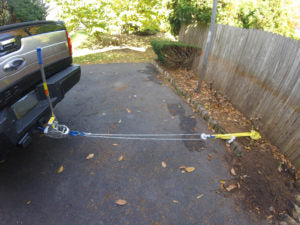Stump Removal with a Cable Ratchet Winch Hoist

A cable ratchet winch hoist (also known as a come along) is a durable, compact tool that’s ideal for lifting, tensioning, pulling, stretching, and bending in hundreds of precision tasks. Extracting a tree stump is just one of many applications, but cable hoists are commonly used by home owners, as well as commercial landscaping and tree removal services to deal with large tree roots, stumps, and bushes. If you’re looking to remove a stump from your property, grab your cable ratchet winch hoist and follow the steps outlined below!
But, before you begin, make sure your hoist is rated for a capacity conducive to the size of the stump you are trying to remove. Most cable ratchet winch hoists are rated for ½ to 3 tons of pulling power, depending on the make and model. Overloading your hoist can be dangerous, particularly if you’re using a hoist that doesn’t have built-in safety features like a stress link or breakable handle. Purchasing a quality hoist with built-in safety features ensures that you can’t overload it beyond its rated capacity. It’s also important to wear safety glasses and any other personal protective equipment that will keep you safe from flying pieces of wood or metal.
- To start, you will need a cable ratchet winch hoist, along with an additional web strap, tree saver strap, or tow strap. Do not attempt to wrap your cable around the stump, as it may cause fraying or severe damage to the hoist. Your strap should be made of a strong polyester webbing, with loops sewn on both ends to ensure a secure hold. Wrap your additional strap thoroughly around the tree or bush stump, creating as much manual tension as possible.
- Once you’ve wrapped your strap around the stump, grab your cable ratchet winch hoist and attach it to the web strap. Take the shank hook connected to the pulley block assembly at the end of your cable hoist and connect it to the loop at the end of your web strap.
- Next, connect the top shank hook on your cable hoist to a secure stationary object like a vehicle, tree, or support structure that can withstand the pulling power of the hoist and the weight of the stump.
- If using a vehicle: connect the shank hook at the top of the cable hoist to the tow hitch on the back of the vehicle.
- If using a tree or other support structure: you will need another web strap, tree saver, or tow strap to wrap around the stationary object/support structure. Next, you will need to connect the web strap loop to the shank hook at the top of the cable hoist.
- Once the bottom shank hook on your cable hoist is properly attached to the web strap around the stump and the top shank hook on your cable hoist is properly attached to the tow hitch on your vehicle OR the web strap around your secure stationary object, you can begin to ratchet the hoist without the handle attached. To do so, push down on the U-frame and release it in a continuous motion until there’s adequate tension between the stump and the stationary object. The cable hoist and web straps should be pulled tightly from one end to the other so that nothing touches the ground beneath it.
- Remove the wing nut from the hoist’s main frame and attach your handle. Secure the wing nut to ensure it is properly attached. Note: the handle makes it easier to ratchet the hoist, but using the U-frame without the handle first is beneficial because it provides enough tension between the stump and the stationary object that the web strap and cable won’t get tangled, frayed, or in the way of the job.
- Once the handle is securely attached to the main frame, continue to ratchet the hoist using a downward motion on the handle for speedier, more effective tensioning.
- Move the handle down and up in a continuous motion until the roots or stump begin to pull free from the ground.
- If necessary, you can grab an axe or hatchet to cut through stubborn roots or help loosen up the ground around the stump before returning to the hoist.
- Return to the hoist, if applicable, and continue to ratchet in a downward motion until the stump is completely freed from the ground and the roots are no longer attached to the earth.
